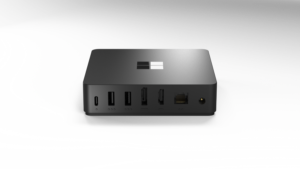Windows 365 Link: Cloud PC Just Got Real
We’re all used to the idea of a PC being a device—your laptop, your desktop, maybe even a fancy all-in-one. But what if your "PC" wasn’t really a PC at all? Enter the Windows 365 Link, Microsoft’s compact bridge between you and the cloud. It’s not here to replace your hardware entirely, but to rethink how we use it.
The Link is designed to connect directly to your Windows 365 Cloud PC, making your workspace portable, secure, and—most importantly—not tied to a traditional endpoint. Let’s break down what this means for how we work and why it might be a big deal for businesses. It’s a rethink of how we approach security, management, and productivity. It also closes the missing gap that was present in the W365 ecosystem.

No Physical Attack Surface, No Problem
One of the Link’s standout features is its complete lack of local storage. No files, no apps, no admin accounts. At first, that might seem limiting, but here’s the genius: there’s nothing on the device for attackers to exploit. If the Link is stolen, it’s just a tiny paperweight for anyone who doesn’t have access to your Cloud PC.
For businesses handling sensitive data, like finance or healthcare, this is a game-changer. Local machines are always at risk of being breached or compromised. The Link removes that risk entirely by keeping everything in the cloud. It’s like a secure tunnel that ensures your data is always protected, no matter where you are.
- Physical theft: Lose a laptop, and your data could end up anywhere. Lose the Link? There’s nothing stored locally for attackers to exploit.
- Malware attacks: The locked-down OS prevents unauthorized software from running or installing locally, drastically reducing the risk of breaches.
- Privileged escalations: No local admin accounts mean attackers can’t exploit traditional elevation-of-privilege attacks to gain control.
For industries that deal with sensitive information—finance, healthcare, or government—the reduced attack surface makes the Windows 365 Link an obvious choice.
Built for Privileged Access Workstations (PAWs)
If you’ve ever tried to implement Privileged Access Workstations (PAWs), you know they’re a hassle. These specialized devices are designed for highly secure tasks—think system administration or managing sensitive data—but they’re costly and complex to set up. The Windows 365 Link changes that.
With no local data and built-in support for FIDO2 security keys, the Link makes securing privileged access much simpler. Passwordless, hardware-backed authentication means no weak passwords to exploit, and no need for bulky, high-spec machines just for security’s sake. At $349, it’s a cost-effective way to deploy secure workstations without sacrificing functionality. For IT admins, it’s a quick win that checks all the compliance boxes without breaking the budget.
- Secure by design: With no local admin accounts or storage, the Link aligns perfectly with the zero-trust principles of PAWs.
- Enhanced authentication: The device supports FIDO2 security keys, enabling passwordless, hardware-backed authentication for privileged users. This reduces the risk of phishing attacks and ensures only authorized personnel can access sensitive systems.
- Cost-effective: At $349, it’s significantly cheaper than building out dedicated, high-end PAW setups while offering superior security through cloud-native management.
Built for Hybrid Work
Perfect for the Hybrid Work Era
Hybrid work isn’t a trend anymore—it’s the way we work now. But with hybrid setups come challenges: laptops lugged between home and office, forgotten chargers, and inconsistent environments. The Link offers a simple solution.

It’s small, portable, and packed with modern connectivity. Dual 4K monitor support, Wi-Fi 6E, Bluetooth 5.3, and Ethernet mean it’s ready for just about any setup. Plug it into a monitor and peripherals, and you’re instantly connected to your Cloud PC. No need to sync files or carry around a full device.
This isn’t just handy for hybrid workers—it’s perfect for hot-desking environments, too. Instead of provisioning expensive laptops for every desk, you just provide a Link. Simple, scalable, and far less hassle for IT.
- Dual 4K monitor support for high-productivity setups.
- Wi-Fi 6E, Bluetooth 5.3, and Ethernet connectivity to ensure compatibility with any network.
- Plug-and-play simplicity that turns any screen into a secure workstation connected to your Cloud PC.
IT Management Without the Drama
If you’re an IT admin, you’ve probably rolled your eyes at “revolutionary” devices that make big promises but add complexity to your workload. The Link is different because it’s built to integrate seamlessly into the tools you’re already using, like Microsoft Intune.
From zero-touch provisioning to automatic updates, managing the Link is as straightforward as managing a traditional endpoint. Policies? Same as any other device. Updates? They’re applied in the background overnight. It’s an endpoint that fits neatly into your existing processes without reinventing the wheel.
And because it’s entirely cloud-driven, there’s no need to worry about patching local vulnerabilities, maintaining a separate device inventory for physical machines or even having these on your internal facing LAN. It just works.
Why It Matters
The Windows 365 Link might look like a small, unassuming device, but it’s tackling some big problems. It removes local vulnerabilities, simplifies endpoint management, and makes hybrid work more efficient. For businesses already using Windows 365, it’s an obvious next step. For those on the fence about cloud PCs, it might just be the nudge they need.
This isn’t about replacing every device in your organization, but about rethinking how and where you work. The Link isn’t flashy, and it doesn’t need to be. It’s about utility—making your workspace more secure, more portable, and less of a headache for everyone involved.
Final Thoughts
The Windows 365 Link isn’t going to revolutionize how you work overnight. But it’s a clear step toward a world where your "PC" isn’t tied to a physical machine. It’s secure, simple, and built for modern work.
If you’re managing hybrid teams, privileged users, or just looking to simplify your endpoint strategy, this little device is worth a closer look. It’s not the whole solution, but it might just be the most practical piece of the puzzle you’ve been missing.
